#alan mcnamee
Explore tagged Tumblr posts
Text

Hide your wallets, it's that time again! Your daily thread of romance deals is ready, FREE to $2.99!

FREE ✦ Billionaire Lumberjack's Baby by Gwyn McNamee
1st POV. An emotionally wounded billionaire hiding out in the mountains gets a surprise visit from his lawyer. She was tasked with dropping off his baby from a 1NS.
Contemporary Romance (MF) | https://amzn.to/3N1LB48

$0.99 ✦ The Duke's Cowboy by Andrew Grey
A Duke fleeing familial expectations ends up in a small US town when a blizzard forces him off the road and into the warmth of Alan's ranch.
KU Title
Contemporary Romance (MM) | https://amzn.to/3XYGkRy

$1.99 ✦ A Winter Scandal by Candace Camp
When she finds a baby left in the church nativity scene, she notices a brooch belonging to a rakish Lord. But he swears the baby isn't his. Together they must find the missing mother.
Historical Romance (MF) | https://amzn.to/3MWecYD

$2.49 ✦ The Deeper I Fall by Erika Kelly
Hockey player + spoiled British heroine. His former coach left him a cattle ranch -- but to inherit it, he must first live and work on the ranch with the estranged daughter.
KU Title
Contemporary Romance (MF) | https://amzn.to/4eACp2q

$2.99 ✦ Bossed by the Boggart by Wendi Guff
1st POV. Boss/employee. He's a boggart, as well as the sunshine one.
Trans woman MC
Paranormal Romance (MF) | https://amzn.to/4edXlMV
Putting these lists together takes time. If you appreciate this content, please consider buying me a Ko-Fi. http://ko-fi.com/danielletbq
#book deals#romance deals#romance novels#romance reader#contemporary romance#historical romance#paranormal romance#mf romance#mm romance
0 notes
Photo




niall | niall | niall | niall
#niall's friends on niall's IG#Alyssa mango#rays of sunshine#nicky conlan#Alan McNamee#ellie stidolph#bressie#robbie keane#Matt Goulet#courtney barry#maren morris#john bird#Cameron azoff#lilli Bridger#mark McDonell#sandy beales#celeste bright#toni terry#marc bartra#corey harper#benjamin evans#dan richards#Alyse Noelle#lucy hale#Justin Stirling#vero iglesias#conor o'donohoe#racquelle Stevens#Adam kerroum#Justin rose
41 notes
·
View notes
Photo










I'm done talking, let's play.
The Battle of the Sexes | Jonathan Dayton and Valerie Faris, 2017
#The Battle of the Sexes#Emma Stone#Steve Carell#Andrea Riseborough#Austin Stowell#Sarah Silverman#Natalie Morales#Alan Cumming#Bill Pullman#Elisabeth Shue#Jessica McNamee#Eric Christian Olsen#Fred Armisen#Jonathan Dayton#Valerie Faris#Film#2017
11 notes
·
View notes
Photo

- I'm the ladies number one. I'm the champ. Why would I lose? - Because dinosaurs can't play tennis.
Battle of the Sexes, Jonathan Dayton and Valerie Faris (2017)
#Jonathan Dayton#Valerie Faris#Simon Beaufoy#Emma Stone#Steve Carell#Andrea Riseborough#Natalie Morales#Sarah Silverman#Bill Pullman#Alan Cumming#Elisabeth Shue#Eric Christian Olsen#Fred Armisen#Martha MacIsaac#Lauren Kline#Mickey Sumner#Fidan Manashirova#Jessica McNamee#Linus Sandgren#Nicholas Britell#Pamela Martin#2017#woman director
5 notes
·
View notes
Text
Battle of the Sexes
(Jonathan Dayton & Valerie Faris, 2017)
Ever since their days directing music videos, Jonathan Dayton and Valerie Faris have had something of an eye for nostalgia in their work. From All Around the World by Oasis, to the Red Hot Chili Peppers’ Otherside, and the iconic and immortal Tonight, Tonight by the Smashing Pumpkins, the majority of their outstanding work in the field was heavily influenced by days gone by.
Now, 5 years on from Ruby Sparks, their sort of under the radar second feature, the husband and wife duo bring said penchant for the nostalgic to their big screen work with a Simon Beaufoy penned chronicling of the most famous tennis match ever played.
The movie is, as most movies of its kind tend to be, pretty much trash history (that’s just going based on well known facts, and not the other assorted rumours) but it is also, as the best movies of its kind tend to be, one hell of a fairytale. For while the movie seems like it simplifies a lot of what went on during this historic period in womens tennis, it never does so to the extent that it loses that something special that ensures it remains engaging drama.
Central to that is the fact that it makes neither demon of Bobby Riggs, nor saint of Billie Jean King (villain duty instead reserved for Jack Kramer, and Margaret Court). Riggs proves probably the most interesting character in the film, one that might have deserved a movie all of his own (even if it still manages to feel like something of a simplistic skirting over the surface of the man) and in being so he provides Steve Carell with a role tailored for him. Carell like few other movie stars around has the ability to play and blend both the achingly soulful, and the side splittingly hilarious, so he’s very much in his element with this one.
Across the court Emma Stone is the heart and soul of the movie, and while the representation of King also feels like something of a simplification of the character (she’s another who could easily make for a magical movie all her own) it still gets enough of that conflict between the confused woman, the tennis champion, and the cultural trailblazer to make her an interesting enough figurehead for the movie, even if I feel like (perhaps in order to remain more engaging to a wider audience) they definitely stop shy of going too deeply into all of that, focusing instead (again) on the more outward, surface level relationship stuff.
Still, as I said, it works well enough at being what it is to avoid earning too much criticism for what it might have been, that’s thanks in large part to the wonderful cast, with Stone and Carell aided by smaller, memorable turns from the magnificent Sarah Silverman doing so much with nothing, Andrea Riseborough, Alan Cumming (hamming it up like few others can), Bill Pullman, Elisabeth Shue, Natalie Morales, Jessica McNamee, and maybe best out of everyone, Austin Stowell, playing a role that feels like an apology, his Larry King’s role in history so massively downplayed in the story that they’ve instead gifted him with the most sympathetic, likeable character in the film.
Yet I think ultimately you have to circle back to Dayton and Faris when handing out ultimate credit. Their production is so smooth that the niggling problems someone might take with Beaufoy’s writing don’t matter, their handle on their performers so strong, things handled with a lightness of touch that keep proceedings palatable for the masses, while at the same time injected with enough weight that this all still feels like it matters.
Battle of the Sexes certainly does a great job at getting across the enormity of the event it recreates, the larger moment in history that surrounded it, and at least a little of the complex nature of its central figures. It proves a great time at the movies, a great sports movie (whether you believe what took place was sport, and not something closer to pro wrestling ^_^), and at least an interesting look back at history, even if it fails to go quite as in depth as the material might have deserved.
#battle of the sexes#jonathan dayton#valerie faris#dayton and faris#simon beaufoy#emma storm#steve carell#sarah silverman#austin stowell#andrea riseborough#alan cumming#bill pullman#elisabeth shue#natalie morales#jessica mcnamee#2017#reviews#film#films#movie#movies#sports#history#jonathan dayton and valerie faris
1 note
·
View note
Note
may we see the christmas book haul? 👀
absolutely! it was a good haul this year 📚👀

apparently this is a total of 41 books, so this should keep me busy until the next book spree in June or July! considering the quarantine situation, it might even be a little sooner this year 😂
full list of titles under the cut!
left pile, top to bottom:
My Testimony by Anatoly Marchenko
Hex by Thomas Olde Heuvelt
The Thief’s Journal by Jean Genet
Motherfoclóir by Darach Ó Séaghdha
The Children’s Blizzard by David Laskin
The Indifferent Stars Above by Daniel James Brown
Midnight in Chernobyl by Adam Higginbotham
Cujo by Stephen King
Working Stiff by Judy Melinek, M.D., and T. J. Mitchell
The Hunger by Alma Katsu
Buried in the Sky by Peter Zuckerman and Amanda Padoan
Chernobyl by Serhii Plokhy
Oh My God, What a Complete Aisling by Emer McLysaght and Sarah Breen
Devils by Fyodor Dostoevsky
This Game of Ghosts by Joe Simpson
Wakenhyrst by Michelle Paver
Jurassic Park by Michael Crichton
After Auschwitz by Eva Schloss
Symphony for the City of the Dead by M. T. Anderson
Ghostland by Edward Parnell
Children of the Troubles by Joe Duffy and Freya McClements
right pile, top to bottom:
The Ruins by Scott Smith
The Climb by Anatoli Boukreev and G. Weston DeWalt
Bury My Heart at Wounded Knee by Dee Brown
Devil’s Day by Andrew Michael Hurley
The Poisonwood Bible by Barbara Kingsolver
The Only Good Indians by Stephen Graham Jones
The Hobbit by J. R. R. Tolkien
So You’ve Been Publicly Shamed by Jon Ronson
The Secret Life by Andrew O’Hagan
Resurrection Man by Eoin McNamee
Wuthering Heights by Emily Brontë
Troop by Nick Cutter
The Way of Shadows by Brent Weeks
The Final Empire by Brandon Sanderson
The Fire Starters by Jan Carson
Man is Wolf to Man by Janusz Bardaeh and Kathleen Gleeson
Red Gold by Alan Furst
Alexander Dolgun’s Story by Alexander Dolgun with Patrick Watson
Till My Tale is Told edited by Simeon Vilensky
Embassytown by China Miéville
20 notes
·
View notes
Video
youtube
Battle of the Sexes (2017)
The electrifying 1973 tennis match between World number one Billie Jean King (Emma Stone) and ex-champ and serial hustler Bobby Riggs (Steve Carell) was billed as The Battle of the Sexes and became one of the most watched televised sports events of all time. The match caught the zeitgeist and sparked a global conversation on gender equality, spurring on the feminist movement. Trapped in the media glare, King and Riggs were on opposite sides of a binary argument, but off-court each was fighting more personal and complex battles. With a supportive husband urging her to fight the Establishment for equal pay, the fiercely private King was also struggling to come to terms with her own sexuality, while Riggs gambled his legacy and reputation in a bid to relive the glories of his past. Together, Billie and Bobby served up a cultural spectacle that resonated far beyond the tennis courts and animated the discussions between men and women in bedrooms and boardrooms around the world.
Directed by: Valerie Faris & Jonathan Dayton
Starring: Emma Stone, Steve Carell, Andrea Riseborough, Sarah Silverman, Bill Pullman, Alan Cumming, Elisabeth Shue, Austin Stowell, Jessica Mcnamee, Natalie Morales, Fred Armisen, Martha MacIsaac, Mickey Sumner, Bridey Elliott, Eric Christian Olsen, Wallace Langham, Matt Malloy
Release date: September 22, 2017
#Battle of the Sexes#Valerie Faris#Jonathan Dayton#Emma Stone#Steve Carell#Andrea Riseborough#Sarah Silverman#Bill Pullman#Alan Cumming#Elisabeth Shue#Austin Stowell#Jessica Mcnamee#Natalie Morales#Fred Armisen#Martha MacIsaac#Mickey Sumner#Bridey Elliot#Eric Christian Olsen#Wallace Langham#Matt Malloy#Movie#Movie Trailers#Film#Sports#Tennis
2 notes
·
View notes
Text
Two of a Space Kind: Apollo 12 and Mars 2020
NASA - Apollo 12 Mission patch / NASA - Mars 2020 Rover logo. Nov. 20, 2019
Image above: (Left) Apollo 12 astronaut Charles “Pete” Conrad Jr. stands beside NASA's Surveyor 3 spacecraft; the lunar module Intrepid can be seen in the distance. Apollo 12 landed on the Moon's Ocean of Storms on Nov. 20, 1969. (Right) Mars 2020 rover, seen here in an artist's concept, will make history's most accurate landing on a planetary body when it lands at Mars' Jezero Crater on Feb. 18, 2021. Image Credits: NASA/JPL-Caltech. Fifty years ago today, during their second moonwalk, Charles "Pete" Conrad Jr. and Alan Bean became the first humans to reach out and touch a spacecraft that had previously landed on another celestial body. NASA's 1969 Apollo 12 Moon mission and the upcoming Mars 2020 mission to the Red Planet may be separated by half a century and targets that are 100 million miles apart, but they share several mission goals unique in the annals of space exploration. "We on the Mars 2020 project feel a special kinship with the crew of Apollo 12," said John McNamee, Mars 2020 project manager at NASA's Jet Propulsion Laboratory in Pasadena, California. "They achieved the first precision landing, deployed the most advanced suite of science instruments of the time, and were the first to interact with another spacecraft that put down on another world. That's all part of the Mars 2020 playbook as well." NASA needed Apollo 12 to prove a precision landing was possible because future Apollo missions would target locations in the lunar highlands, where mountains, massive craters, boulder fields and rilles could ruin their day if the lunar modules strayed from their prescribed landing path. And while the previous mission, Apollo 11, was a monumental success, it overshot its intended landing site in the Sea of Tranquility by about 4 miles (6 kilometers).
Image above: Apollo 12 lunar module pilot Alan Bean holds a container of lunar soil, with the reflection of mission commander Charles "Pete" Conrad Jr. visible on his visor. The image was taken on the Moon's Ocean of Storms on Nov. 20, 1969. Apollo 12's lunar activities included the deployment of the Apollo Lunar Surface Experiments Package (ALSEP), finding NASA's Surveyor 3 spacecraft (which landed on the Moon on April 19, 1967), and collecting 75 pounds (34 kilograms) of rock samples. Image Credit: NASA. To demonstrate a precision landing, Apollo 12 mission planners could have chosen just about anywhere on the nearside of the Moon by targeting any of literally millions of known geologic features. In the end, they chose for Pete and Al a relatively nondescript crater in the Ocean of Storms because JPL had plunked down a spacecraft there two-and-a-half years earlier. "When Pete and Al put the lunar module Intrepid down within about 520 feet [160 meters] of Surveyor 3, it gave NASA the confidence to later send Apollo 15 to Hadley Rille, Apollo 16 to go to the Descartes Highlands and Apollo 17 to land at Taurus Littrow," said McNamee. "We also have to be precise with our landing on Mars — not only to pave the way for future precision landings on the Red Planet for both robotic and human-crewed missions, but also because Mars 2020's scientifically appealing landing site at Jezero Crater has all sorts of cliffsides, sand dunes, boulders and craters that can adversely affect us during landing." Mars 2020 will be history's first planetary mission to include terrain relative navigation, a computerized autopilot that utilizes optical imagers and computers to help Mars 2020 avoid landing hazards and make the most accurate landing on a planetary body in history. Sweet Suite Science There are other similarities. During their first moonwalk, Conrad and Bean deployed the Apollo Lunar Surface Experiments package (ALSEP). Powered by a radioisotope thermoelectric generator, the five science instruments (seismometer, atmospheric sensor, solar wind spectrometer, lunar dust collector and magnetic field sensor) were the most advanced ever to be carried to another celestial body, and they sent back groundbreaking data on the lunar environment from November 1969 to September 1977. When Mars 2020 alights at Jezero Crater, it also will be equipped with the most advanced science instruments ever to travel to another world. "The science instruments we carry benefit not only from advances in technology, but the hard lessons learned by those missions of exploration, including Apollo, that preceded us," said Ken Farley, project scientist for Mars 2020 from Caltech in Pasadena. "Our seven state-of-the-art science tools will help us acquire the most information possible about Martian geology, atmosphere, environmental conditions, and potential biosignatures, giving us insight into the Red Planet like never before."
Image above: Apollo 12 astronauts (left to right) lunar module pilot Alan Bean, command module pilot Richard Gordon and commander Charles “Pete” Conrad Jr. relax during a flight rehearsal in the Apollo mission simulator. Image Credit: NASA. Return to Sender During their second moonwalk, Conrad and Bean reached the Surveyor 3 lander — one of the robotic missions that explored the Moon in advance of astronauts. They not only collected images and samples of the lunar surface surrounding the spacecraft, but cut, sawed and hacked parts off the three-legged spacecraft, including Surveyor's TV camera and its surface-soil sampling scoop. "NASA wanted to see what happened to materials that were exposed to the lunar environment for an extended period," said McNamee. "To this day, the samples of Surveyor 3, which endured 31 months at the Ocean of Storms, are our best and only demonstrations of the natural processes that can affect spacecraft components left on the Moon."
Image above: A graphic novel chronicling the historic flight of Apollo 12. Image Credits: NASA/PPG. One of Mars 2020's major mission goals is to seek signs of past microscopic life, collecting the most compelling rock core and Martian dust samples. Subsequent missions, currently under consideration by NASA, would send spacecraft to Mars to collect these samples from the surface and return them to Earth for in-depth analysis. To help engineers design spacesuits to shield astronauts from the elements, NASA is sending five samples of spacesuit material along with one of Mars 2020's science instruments, called Scanning Habitable Environments with Raman & Luminescence for Organics & Chemicals (SHERLOC). A piece of an astronaut's helmet and four kinds of fabric are mounted on the calibration target for this instrument. Scientists will use SHERLOC, as well as a camera that photographs visible light, to study how the materials degrade in ultraviolet radiation. It will mark the first time spacesuit material has been sent to Mars for testing and will provide a vital comparison for ongoing testing at NASA's Johnson Space Center. Robots First, Astronauts Later Just as NASA's Surveyor missions helped blaze a trail for Neil and Buzz on Apollo 11, Pete and Al on 12, as well as Al and Ed (Apollo 14), Dave and Jim (Apollo 15), John and Charlie (Apollo 16), and Gene and Harrison (Apollo 17), Mars 2020 is helping set the tone for future crewed missions to Mars. Mars 2020's landing system includes a suite of sensors that will document the descent to the surface in never-seen-before detail so that future robotic and crewed missions factor those details into their landings. When on the surface, the rover's MOXIE instrument is designed to demonstrate that converting Martian carbon dioxide to pure oxygen is possible, and RIMFAX could teach us how to use ground-penetrating radar so that future missions can use it to find sources of fresh water. "Isaac Newton once wrote, 'If I have seen further it is by standing on the shoulders of Giants,'" said McNamee. "When Mars 2020 flies, it will allow us to see farther into the geologic history of the Red Planet than ever before — and that is happening because we too are standing on the shoulders of giants — giants like the crew of Apollo 12." The launch period for Mars 2020 opens on July 17, 2020. It will land at Mars' Jezero Crater on Feb. 18, 2021. Related links: Surveyor 3 lander: https://solarsystem.nasa.gov/missions/surveyor-3/in-depth/ Scanning Habitable Environments with Raman & Luminescence for Organics & Chemicals (SHERLOC): https://mars.nasa.gov/mars2020/mission/instruments/sherloc/ Apollo: https://www.nasa.gov/mission_pages/apollo/index.html Apollo 12: https://www.nasa.gov/mission_pages/apollo/apollo-12 Apollo 14: https://www.nasa.gov/mission_pages/apollo/missions/apollo14.html Apollo 15: https://www.nasa.gov/mission_pages/apollo/missions/apollo15.html Apollo 16: https://www.nasa.gov/mission_pages/apollo/missions/apollo16.html Apollo 17: https://www.nasa.gov/mission_pages/apollo/missions/apollo17.html MOXIE: https://mars.nasa.gov/mars2020/mission/instruments/moxie/ RIMFAX: https://mars.nasa.gov/mars2020/mission/instruments/rimfax/ Mars 2020 Rover: http://www.nasa.gov/mars2020 Moon to Mars: https://www.nasa.gov/topics/moon-to-mars/ Images (mentioned), Text, Credits: NASA/Tony Greicius/Alana Johnson/JPL/DC Agle. Greetings, Orbiter.ch Full article
12 notes
·
View notes
Photo








niall | conor | thriston | maren | angela | robbie
#niall's friends on niall's IG#Emily cybak#Shane Kimbrough#thomas bjorn#Guido migliozzi#Reeve whitson#christiaan bezuidenhout#shane lowry#Hayden sylte#adam kerroum#Alan McNamee#sandy beales#mark McDonell#Charles porch#tom davies#conor syme#kevin pietersen#Matt Fitz#olympia valance#jacksingh brar#lyzy adler#gerry morgan#joe wicks#Alyssa mango#benjamin evans#marcos alonso#niall's IG activity 2017 unseen thread#robbie keane#Angela akins#conor McGregor
26 notes
·
View notes
Photo
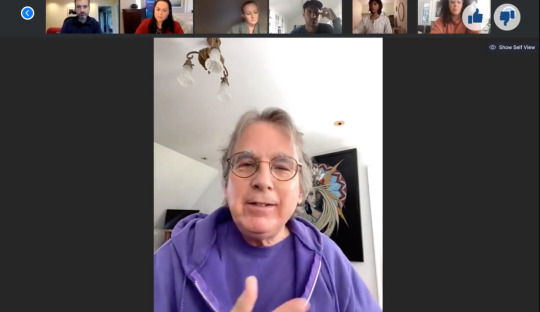
Facebookの「監査審査会」に対抗し活動家による「真の監査審査会」が発足 米国時間9月30日、学者、研究者、公民権運動の指導者などからなるグループがThe Real Facebook Oversight Board(真のFacebook監査審査会)を発足させた。来たる米国大統領選挙におけるFacebook(フェイスブック)の役割を批判・議論するための会だ。メンバーには、元Facebook選挙セキュリティー責任者、#StopHateForProfit キャンペーンのリーダー、およびFacebookの初期投資家であるRoger McNamee(ロジャー・マクナミー)氏が在籍している。Facebookは昨年11月にコンテンツ管理の厄介な問題に対応するために「監査審査会」を自社で立ち上げたが、選挙期間中にコンテンツや活動を監視するつもりはなく、選挙終了後に問題を審査するだけであることを、正式に認めている。 発足記者会見は以下のチャンネルで中継される。 Facebook創業者のMark Zuckerberg(マーク・ザッカーバーグ)氏は昨年11月、監査審査会は「極めて重要な取り組み」であり「社内の各チームが意思決定に集中しすぎることを防ぐ」とともに「説明責任と監視」を促進すると強調した。 それはFacebook内での意思決定の難しさを認めた行動とも見られた。物議を巻き起こす投稿��削除するかどうかの判断は、個々の幹部の責任となることから、監査審査会はコンテンツ管理の「最高裁判所」のような役割になると言われている。 しかし審査会は、意思決定には最長3カ月を要し、審査の対象はプラットフォームから削除されたコンテンツのみであり、残っているものは審査しないことを認めている。 Facebookはこの審査会に1億3000万ドル(約137億1700万円)を投資し、5月にデンマークの元首相であるHelle Thorning-Schmidt(ヘレ・トーニング・シュミット)氏やGuardian(ガーディアン)紙の元編集長であるAlan Rusbridger(アラン・ラスブリジャー)氏などで構成される初期の委員会メンバーを発表した。
0 notes
Video
youtube
Battle of the Sexes (2017)
The electrifying 1973 tennis match between World number one Billie Jean King (Emma Stone) and ex-champ and serial hustler Bobby Riggs (Steve Carell) was billed as The Battle of the Sexes and became one of the most watched televised sports events of all time. The match caught the zeitgeist and sparked a global conversation on gender equality, spurring on the feminist movement. Trapped in the media glare, King and Riggs were on opposite sides of a binary argument, but off-court each was fighting more personal and complex battles. With a supportive husband urging her to fight the Establishment for equal pay, the fiercely private King was also struggling to come to terms with her own sexuality, while Riggs gambled his legacy and reputation in a bid to relive the glories of his past. Together, Billie and Bobby served up a cultural spectacle that resonated far beyond the tennis courts and animated the discussions between men and women in bedrooms and boardrooms around the world.
Directed by: Valerie Faris & Jonathan Dayton
Starring: Emma Stone, Steve Carell, Andrea Riseborough, Sarah Silverman, Bill Pullman, Alan Cumming, Elisabeth Shue, Austin Stowell, Jessica Mcnamee, Natalie Morales, Fred Armisen, Martha MacIsaac, Mickey Sumner, Bridey Elliott, Eric Christian Olsen, Wallace Langham, Matt Malloy
Release date: September 22, 2017
#Battle of the Sexes#Valerie Faris#Jonathan Dyton#Emma Stone#Steve Carell#Andrea Riseborough#Sarah Silverman#Bill Pullman#Alan Cumming#Elisabeth Shue#Austin Stowell#Jessica Mcnamee#Natalie Morales#Fred Armisen#Martha MacIsaac#Mickey Sumner#Bridey Elliot#Eric Christian Olsen#Wallace Langham#Matt Malloy#Movie#Movie Trailers#Film
2 notes
·
View notes
Photo
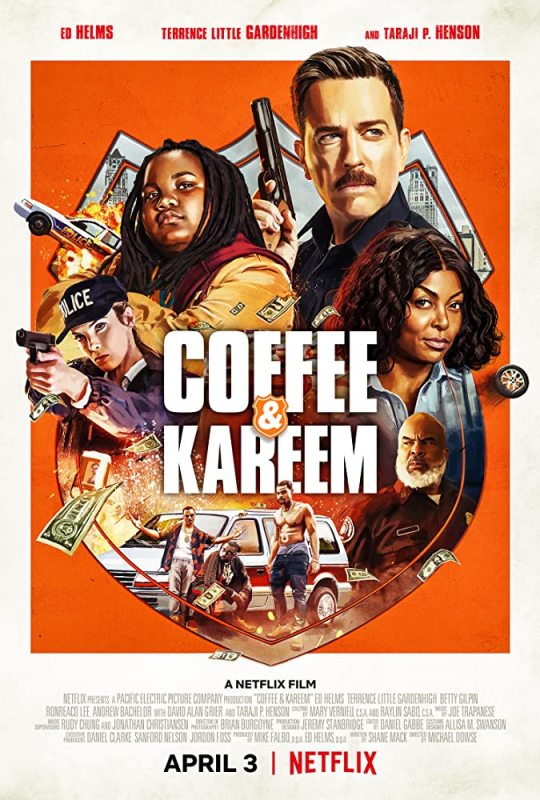

CALIFICACIÓN PERSONAL: 4 / 10
Título Original: Coffee & Kareem
Año: 2020
Duración: 88 min
País: Estados Unidos
Director: Michael Dowse
Guion: Shane Mack
Música: Joseph Trapanese
Fotografía: Brian Burgoyne
Reparto: Ed Helms, Terrence Little Gardenhigh, Betty Gilpin, Taraji P. Henson, Jesse Hutch, David Alan Grier, Chance Hurstfield, Andrew Bachelor, Fraser Aitcheson, Samantha Cole, Garfield Wilson, RonReaco Lee, Serge Houde, Frankie Hopkins, Caitlin Mitchell-Markovitch, Donald Sales, Eduard Witzke, Adam Thomas, Kat Pasion, Ian Hawes, Ava Franklyn, Erik McNamee, Alexandra Aranibar
Productora: Pacific Electric Picture Company. Distribuida por Netflix
Género: Action, Comedy
https://www.imdb.com/title/tt9898858/
TRAILER: https://www.youtube.com/watch?v=bu8ohCeBoEY
0 notes
Text
New story in Politics from Time: The Trump Campaign Has Raised Millions Off Impeachment — And Facebook Is One of Its Most Powerful Tools
Onstage in the packed, thunderous hockey arena in Sunrise, Fla., President Donald Trump’s campaign manager Brad Parscale urges the crowd to pull out their cell phones and text themselves onto the campaign’s contact list. Their phones are key to helping Trump get re-elected in the face of his likely impeachment by the House. “The way we fight back,” Parscale booms, “is to get online ourselves and get connected, sign up for emails.” A slap shot away from Parscale, voter Alan Huber doesn’t need to sign up. He is already connected and gets Trump campaign messages, most often by scrolling through Facebook. “I don’t have to watch Fox or CNN or read TIME magazine or anything else. I will get anything important from my Facebook feed,” says Huber, who’s in his 60s and drove down the Florida coast from Boynton Beach on Nov. 26 to see Trump in person. “I think that the media doesn’t fully appreciate the power of the Facebook feed.”

TIME Photo-illustration. Trump: Win McNamee–Getty Images
The Trump campaign does. In the weeks since House Speaker Nancy Pelosi’s Sept. 24 decision to launch an impeachment inquiry against Trump for using the power of his presidency to press a foreign country–Ukraine–to investigate a political rival, the Trump campaign hasn’t run from Pelosi’s impeachment push or settled into a defensive crouch. Campaign officials instead are leaning into the impeachment threat, using it to mobilize supporters and try to extract a political price–and millions of dollars in fundraising–from the Democrats’ move. One of the single most powerful weapons in the Trump campaign’s arsenal has been Facebook, which–unlike many TV stations and newspapers–does not monitor candidates’ political ads for veracity.
A TIME analysis of publicly available Facebook data, which included the cataloging of hundreds of distinct messages, shows how Trump is using social media to supercharge his pushback against impeachment and add to his considerable $150 million war chest. Ads that many Americans would otherwise never see have been tested and tailored to solicit responses from older voters, deploying Trump’s distinctive use of capital letters and words like scam and witch hunt.

Pelosi’s announcement came on a Tuesday. By the end of that week, the campaign had spent more on Facebook ads than in any week since Facebook began reporting political ad spending in May 2018, topping both the aftermath of special counsel Robert Mueller’s investigation and the massive push in the run-up to the 2018 midterm elections, according to TIME’s analysis. In the weeks since, the Trump campaign has paid Facebook more than $5.4 million for ad placements, generating well over 100 million appearances on user feeds.
The spending may be paying for itself. Within 72 hours of Pelosi’s announcement, the campaign had raised $15 million in small-dollar donations. On a typical day, it raises approximately half a million in small-dollar donations–those of $200 or under. On Oct. 31, the day the House voted to approve rules for the impeachment inquiry, the campaign raised more than $3 million, around six times the norm, a senior campaign official tells TIME.
Which means that even as White House lawyers have been outwardly blocking access to documents and officials and dismissing the House’s work as illegitimate, the Trump campaign has embraced impeachment as a means of rallying support and donations in an extraordinarily aggressive Facebook campaign that sometimes includes Instagram–which is owned by Facebook–and that is augmented by spending on Google and other digital platforms. TIME’s analysis shows that about two-thirds of the spending goes to ads that either explicitly mention impeachment or unambiguously allude to the House investigation.
The sheer volume of the Trump campaign’s presence on social media, and the money behind it, means that for a substantial number of Americans who thumb through Facebook for personal and national news, the campaign stands a good chance of actually delivering its version of events, no matter the reality. “The campaign has done a good job of telling us what the news is in case we don’t see it on Fox,” Huber says.
That raises issues. Trump is using the fallout from impeachment to reach more voters and donors on a platform that’s come under fire for being a tool of election meddling, especially after Russia used Facebook and other social-media platforms to stir up animosity, spread falsehoods and organize real-life protests against Hillary Clinton in 2016. A Facebook spokesperson did not want to comment in depth but noted that Democratic candidates have also invested heavily in advertising on the platform. Facebook advertising data shows Trump has spent $16.2 million on Facebook so far this year. That compares with $14.2 million spent by Tom Steyer, $5.9 million by Pete Buttigieg, $4.9 million by Elizabeth Warren, $4.8 million by Bernie Sanders and $3.1 million by Joe Biden.
From the White House, Jared Kushner has been convening meetings to coordinate the messaging on impeachment between the White House, the campaign and Congress. A tight group made up of Kushner, Parscale, Republican National Committee chair Ronna McDaniel and House minority leader Kevin McCarthy have decided to try to play impeachment to Trump’s advantage, launching a campaign to stonewall Congress and to paint the process as partisan and unfair to Trump–and to voters. They believe impeachment helps the GOP’s chances of winning back the House by putting the squeeze on Democrats who won in the 31 districts that went for Trump in 2016, says a senior Trump aide. “When this first happened, people were running around with their hair on fire saying, ‘He’s gonna be impeached!'” the aide says. “They can be tough, but we can be tougher. They keep making up their own rules because Trump is not natural to Washington. And then when we break the rules back, they get incensed by it.”
That’s not to say Trump wasn’t furious he was being impeached. Trump hates having the I word attached to his legacy. But since it has become all but inevitable that the House will vote to impeach him, even if the GOP-controlled Senate keeps him in office, his campaign has kicked into gear to use the issue. When impeachment news is “whipped up into a frenzy,” campaign officials see a dramatic spike in small-dollar donations, in people clicking on Trump ads, and in voter data collected, the campaign’s director of communications Tim Murtaugh tells TIME. “Every time this happens, the President’s campaign gets bigger and stronger,” Murtaugh claims.
National polls don’t quite back that up, and Democrats have gambled that a high-wattage impeachment trial in the Senate will dampen enthusiasm for the President, ramp up Democratic voter turnout in 2020 and damage Trump’s re-election chances.
Across the country, public support for impeachment is about 5 points higher than opposition in most polls. If anything, polls indicate Republicans and Democrats have dug deeper into a stalemate over impeachment. Following a small dip after the impeachment investigation began in late September, Trump’s job approval has remained virtually unchanged since summer. Gallup polling in the first two weeks of November found that 43% of Americans approve of Trump, identical to his standing before Pelosi’s announcement.
When Trump took the stage in Sunrise, he did not avoid the topic. He accused “the radical-left Democrats” of being “maniacs” pushing “deranged impeachment” and “trying to rip our nation apart.” He said his support is going up because “people don’t like watching a scam.” Then Trump reached for a line campaign officials believe will take the Democrats’ momentum on impeachment and turn it in Trump’s favor. “The failed Washington establishment,” he said, “is trying to stop me because I’m fighting for you.”
Trump’s weaponizing of social media is well known. But interviews with senior Trump campaign staff and TIME’s analysis of more than 325,000 Facebook ad buys lifts the veil on just how Trump has used that weapon since impeachment kicked off. The first wave came during the 28 minutes after Pelosi stepped out of her office in the Capitol and stated that the House would pursue its authority of “the utmost gravity: approval of articles of impeachment.” The time was 5:04 p.m. Four minutes later, shortly after Pelosi had left the podium, Trump responded on Twitter, calling it “Witch Hunt garbage.”
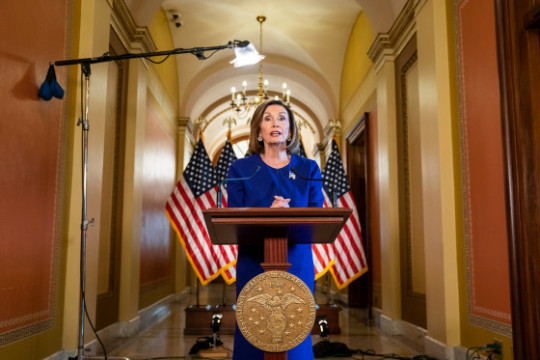
Jim Lo Scalzo—Picture-Alliance/DPA/APSept. 24, 5:04 p.m.: Nancy Pelosi formally announces the House will pursue articles of impeachment.

3.5 min. later: Trump tweets in response: “Witch Hunt garbage.”

23 sec. later: Trump campaign opens Facebook ad blitz, unleashing a flood of advertising with the message: “The ONLY thing stopping Democrats from carrying out their impeachment WITCH HUNT is Patriotic Americans standing with President Trump.”
And less than 30 seconds after that tweet, the President’s re-election campaign unleashed a flood of paid Facebook advertising with a defiant message: “The only thing stopping Democrats from carrying out their impeachment Witch Hunt is Patriotic Americans standing with President Trump.”
Over the course of 20 minutes, the campaign spent an estimated $100,000 to target the ad to an estimated 2 million Facebook accounts, hitting every state but weighting the target audience more heavily than usual toward the 45-and-over crowd–the group that according to 2016 exit polls was more likely to support Trump than Clinton. Above photos or videos depicting Trump or his Democratic rivals, viewers were encouraged, in all caps, to Donate to the Official Impeachment Defense Fund Now!, which, if clicked, led to a generic campaign-donation page.
Three days later, the Democratic committees charged with the impeachment investigation issued their first subpoena of the inquiry to Secretary of State Mike Pompeo, who has yet to respond. By that morning, Sept. 27, the campaign had purchased roughly $1.3 million in ads to be displayed at least 15 million times and was well on its way to outpacing the previous most-expensive week in the past 18 months, when it carpeted Facebook with ads supporting Republicans in the midterm elections. (Weekly figures may grow higher because daily reported expenditures tend to lag in reporting.)
The vast majority of ads mimic, to an almost uncanny degree, the President’s distinct wordsmithing on Twitter, down to the frequent capitalization of words or sentences, the vitriol and the uncharitable nicknames for political foes. Beginning on Nov. 13, the first day of open hearings in the investigation, the campaign unleashed a set of ads stating, “The Impeachment Scam hearings begin today! This is a complete Fake Hearing to interview Never Trumpers and a Pelosi-Schiff SCAM against the Republican Party and me.”
When a user shares an ad, it still appears as Trump-sponsored content on the original user’s feed, but not on the feed of the Facebook friend viewing the shared post. And unlike a campaign designed by an ad agency, these messages are cheap to produce. All you need is a message, some visuals and a call to action.
The messages evolve in almost Darwinian fashion as the campaign field-tests them to see which grab voters. “They’re always trying variations of ads, text, pictures, they test everything,” a campaign official said. “They test what color of the donate button works best.”
Just after Pelosi’s announcement, for example, there were two versions of what was otherwise the same fundraising message, nearly word for word. Each stated, “The ONLY thing stopping Democrats from carrying out their impeachment Witch Hunt is Patriotic Americans standing with President Trump,” but one kind suggested a $45 donation and the other did not.
Each was sent to about 80 different groups. Some were small, targeted ad buys in batches of less than $100. Others were big-ticket purchases that reached hundreds of thousands of users and cost at least $10,000. Both kinds of ads continue to appear, but the one suggesting a $45 donation has been promoted more aggressively. Campaign staff test and write Facebook and other social-media messaging from a warren of cubicles on the 14th floor of an Arlington, Va., office building and have field-tested several hundred messages since Pelosi’s announcement.
Social-media companies survive on their ability to allow advertisers to microtarget groups with extraordinary specificity. That’s particularly true on platforms like Facebook, where many users volunteer information about everything from their age and marital status to their interests, hobbies and opinions. In a recent Washington Post op-ed, Ellen L. Weintraub, the chair of the Federal Election Commission, warned that the ability to home in on a target audience in such detail lets political campaigns “single out susceptible groups and direct political misinformation to them with little accountability, because the public at large never sees the ad.” In March, Facebook addressed some of these concerns with its expanded Ad Library Report, where anyone–including those who do not have Facebook accounts–can browse ads about any topic and see the aggregate spending over time by those who pay for them. For an individual ad campaign, the site reports the percentage of the ad’s audience in each state, as well as their age ranges and genders. The Ad Library Report provides a range of how much each ad campaign costs and how many times the ad appeared in user feeds, as well as daily breakdowns of a campaign’s spending on Facebook ads. From Nov. 1 to Dec. 1, the Trump campaign spent $1.97 million on Facebook ads, the report says. By comparing those spending patterns to the appearance of ads, TIME was able to confidently estimate how much the campaign spent for any ad blast.
TIME analyzed hundreds of digital campaign ads and found that nearly all of Trump’s Facebook messages about impeachment fit into three categories: “The Democrats Are Against You,” “The Democrats Are Against Me” and “The Democrats Are Against America.”
The same motifs repeat with such regularity that the messaging, all together, plays like 12-bar blues: three dominant chords on repeat, with the occasional substitution. “The Democrats Are Against You” ads frequently warn that Democrats are intent on “silencing” or “intimidating” Trump supporters. “The Democrats Are Against Me” ads are the most apocalyptic, saying things like “The future of American freedom rests on the shoulders of men and women willing to defend it from these hateful impeachment attacks.” “The Democrats Are Against America” messages are the most personal and frequently cite Democrats by name. For example: “We need to send a Resounding message to the left that big-government socialists like Alexandria Ocasio-Cortez and Ilhan Omar don’t represent the views of the American people!” A small percentage of ads propagate widely debunked stories about collusion between then Vice President Joe Biden and the Ukrainian government, with messages like “Joe Biden boasted that as vice president he threatened to withhold $1 billion in foreign aid from Ukraine unless they fired the prosecutor looking into a lucrative contract held by his son, Hunter Biden. Learn the real truth about Democrats!”
With the political trenches getting deeper, the campaign’s social-media blitz alone is unlikely to persuade new voters to cross over to Trump. And there is probably nothing the Democrats could uncover that would change Diane Edwards’ mind about voting again for Trump. Edwards, a retired hairdresser who lives in rural Coin, Iowa, is “sick off all this impeachment crap,” adding, “Our country elected him. Everybody has faults, but I think overall he’s doing a good job.”
“It actually makes me support him more. I don’t like what they are doing to him,” says Jennifer Csaszar, 49, who attended Trump’s recent Florida rally from nearby Boca Raton with a friend. “I want to know what the Bidens did.”
When Democrats first announced the inquiry, they knew amassing bipartisan support would be a long shot. But they held out slight hope that if irrefutable evidence emerged showing the President dangled foreign assistance to the new Ukrainian government as leverage for an investigation into Biden and his family, some Republicans would deem it impeachable. That hasn’t happened.
Consider Carol and Rodney Smith, of Thomasville, N.C. Carol has been glued to the impeachment hearings and screams a lot at the television, she says, sitting with her husband Rodney at a Winston-Salem chicken-stew Republican fundraiser in late November. “The Democrats are trying to crucify him,” Carol says, adding that she doesn’t think Trump’s done “anything that former Presidents haven’t done at some point in time.” Rodney, a pastor at a Baptist church who doesn’t affiliate with a political party, also doesn’t think Trump’s actions justify removing him from office. “I’m not saying what he did was right. I just don’t think it’s impeachable.”
The entire impeachment exercise “has pushed people into their corners, and now you’ve got the jerseys on,” says David Kochel, a Republican strategist. “Republicans are putting on the red jersey, Democrats are putting on the blue jersey, and it’s kind of a polarizing time.” Once the majority-Democratic House votes to impeach Trump–which is likely–it will be up to the Senate to hold a trial and vote on whether he should be removed. The trial is likely to begin in January.
But Trump is resoundingly popular among Republicans, and it is this core strength of support that props up the Republican firewall in the Senate–making it politically risky for any Senator to come out against Trump. Senate majority leader Mitch McConnell, one of the sharpest tacticians in the Republican Party’s history, has told his conference to pick one consistent reason to oppose impeachment–be it over Democrats’ motives, legislative process or judicial fairness–and stick with it. In poll after poll, GOP voters have rejected impeachment, and McConnell’s insiders says that as long as that number remains above 85%, Republicans’ majority of 53 seats can be preserved–making it very unlikely Trump will be removed from office.
“Abandoning the President is political suicide,” says Matt Beynon, a Republican strategist and alumnus of Rick Santorum’s bids for the White House. “You’re going to get tied to the President no matter what. You’re on the ticket with him. If you abandon him, all you’re going to do is infuriate the base. And that’s a very powerful base.”
There’s even a growing feeling inside Trump’s inner circle that he may emerge from the impeachment process stronger, assuming the GOP firewall in the Senate does not crack and there are no new revelations. (Senate Republicans backed Richard Nixon until audiotapes showed he knew early on about the break-in at the Democratic National Committee office at the Watergate.) Coming out the other side, his aides argue, would further strengthen support among Trump’s base and weaken future attempts to undermine him.
At the beginning of Trump’s rally in Sunrise, pastor Mario Bramnick delivered a prayer that echoed the campaign’s strategy to use impeachment as a weapon, likening it to a “demonic storm” that was “coming to try to destroy our nation.” “That which the enemy has designed against our President–and to stop God’s plan for our nation through him–must cease and desist,” Bramnick, who was introduced as a member of the advisory board of Latinos for Trump, told the thousands of Trump supporters, many with their heads bowed. “I declare what the enemy meant for evil, God turn around for good.”
–With reporting by ALANA ABRAMSON and PHILIP ELLIOTT/WASHINGTON and LISSANDRA VILLA/CLARINDA, IOWA
By Brian Bennett and Chris Wilson on December 05, 2019 at 06:34AM
0 notes
Text
Billie Jean King – Love: The Queer Gaze in “Battle of the Sexes”
*Contains some mild spoilers for Battle of the Sexes Battle of the Sexes (2017) has been advertised as a tennis movie, which is unsurprising given that it’s a retelling of the infamous 1973 match between Bobby Riggs (Steve Carrell) and Billie Jean King (Emma Stone). But in the midst of all of that tennis, there is a surprisingly beautiful queer love story that hasn’t garnered nearly as much attention as the numerous clips of Bobby Riggs spewing misogyny. It’s 2017 and it’s frustrating to feel surprise when a queer romance is portrayed well onscreen, but Battle of the Sexes is almost exhilarating at times because the relationship between Billie Jean and her hairdresser, Marilyn Barnett (Andrea Riseborough), is portrayed with such delicacy and respect that it’s easy to forget about the tennis completely and instead focus on the film’s refreshingly queer gaze. It would be easy for Battle of the Sexes to fall into tropes typical of queer cinema. After all, it dances around many themes that are all too common (and increasingly tired) when it comes to chronicling the gay experience: gay panic, sexual confusion, and homophobia. Not that these are unimportant, quite the opposite, but the way they are interpreted needs reconsideration and new life. Billie Jean is a married woman, her husband, Larry (Austin Stowell), is, in her own words, “a good man.” She is undoubtedly confused by her own longings and frightened, a fear made manifest by her tennis rival, Australian champion, Margaret Court (Jessica McNamee), who describes Billie Jean’s rumored lesbianism as sinful and immoral. But Battle of the Sexes reclaims these stereotypical narratives by carefully shifting how these tropes play out. Billie Jean certainly experiences panic in her burgeoning relationship with Marilyn, but there is also a sense that she is aware of the inevitability of her desire. She is scared because she knows that being openly queer will lead to the loss of her career and, to a lesser extent, her family, but she also recognizes that what is happening between her and Marilyn is important and undeniable. The depiction of Margaret Court is also notable because while it may seem that Bobby Riggs is supposed to be the villain, it’s Court’s homophobia that makes her an unsympathetic figure. When she loses her own tennis match with Bobby Riggs, the women of the film are devastated, concerned that her loss will set the Women’s Liberation Movement back, but for an audience that knows Court frowns upon Billie Jean, it’s difficult to feel any compassion for her. The great love of Billie Jean’s life is tennis and her laser focus on the game stands in stark contrast to how she is depicted when Marilyn appears on camera. Their first scene together takes place in a hair salon. It’s an obvious safe-space for women as they discuss their upcoming tennis tournament and their dissatisfaction with their male lovers. Marilyn is present the entire time, slightly out of focus, darting about Billie Jean as she cuts her hair, but it is only when Marilyn makes a quip about men that Billie Jean turns from her friends and really focuses on her. And that’s when the tone of the film changes entirely. The camera finds Marilyn in close-up, the focus is on her eyes, her lips, her wrist. Billie Jean is suddenly surrounded by this woman. The scene is sensual in the literal sense of the word, visually the tight close up shots of Billie Jean’s eyes meeting Marilyn’s in the mirror are claustrophobic. The soundtrack swells in what quickly becomes familiar as the film’s Billie Jean and Marilyn love theme. Billie Jean asks about Marilyn’s perfume and the camera lingers on Marilyn’s wrist and hands, there are numerous shots of Marilyn gently touching Billie Jean’s hair. Their meet/cute is not so much ‘cute’ as it is all-consuming. Marilyn is omnipresent in Billie Jean’s world because the camera makes it so. There is nowhere else to look, nowhere else Billie Jean, and by extension, the audience, is invited to look. Marilyn appears fractured, a collection of body parts that only come into view when Billie Jean looks at her. And it’s that look, Billie Jean’s dreamy gaze that elevates their relationship from a subplot to the heart of the film. Their one love scene is again shot in close up. Marilyn removes Billie Jean’s glasses, her armor, her identifier, and it is only then that Billie Jean lets go and allows herself to take what she wants. Like their first meeting, the scene does not focus on the eroticism of their union, but rather the intimacy of the exchange. This is not about nudity or cheap titillation – for a film that spends a lot of time on the chauvinist rhetoric of Bobby Riggs and his ilk, it’s a testament to the sensitivity of the filmmakers that Billie Jean and Marilyn are given an extraordinary amount of dignity in their moment of truest vulnerability. The real love triangle of Battle of the Sexes is not between two women and a man, but rather, between Billie Jean, her love for tennis, and her personal struggle with her sexuality. Larry and Marilyn could be ciphers, both blonde and blue-eyed and inherently kind. They cannot compete with Billie Jean’s dedication to her sport and her cause, but they serve as a visual representation of Billie Jean’s internal struggle. Larry knows her better than anyone. He ices he knees and accompanies her to business meetings. But it’s Marilyn that she seeks with her eyes, Marilyn who sometimes blends into the crowd until Billie Jean looks for her with a gaze that brings her into sharp focus. As the film ends, Ted Tinling (Alan Cumming), who is both the designer of Billie Jean’s uniforms and her queer fairy-godfather tells her, “Times change, you should know, you just changed them.” And that message feels especially relevant when juxtaposed with the image of Emma Stone and Andrea Riseborough nestled together in bold black and white on a recent cover of Out Magazine. Battle of the Sexes does not get trapped by its historical setting, it looks to the future and sees a world Billie Jean King had a hand in creating. And it does this by celebrating its heroine’s queerness, making it as integral and important to the plot as her tennis serve. All photos via Twentieth Century Fox http://dlvr.it/PvKXZK
2 notes
·
View notes
Photo

I contributed to Sad Zine, a digital collection of comics and illustrations about Donald Trump! All proceeds benefit organizations that protect reproductive rights! Olivia Walch, Alan Barrett, Adam Bessie, Peter Chiykowski, David Daneman, Jimmy Grist, Wesley Hall, Josh Hara, John McNamee, Phil Oliveira, Max Rodriguez, Dustin Rogers and Ben Zaehringer! You can get a copy for a $1+ donation on Gumroad!
41 notes
·
View notes
Photo
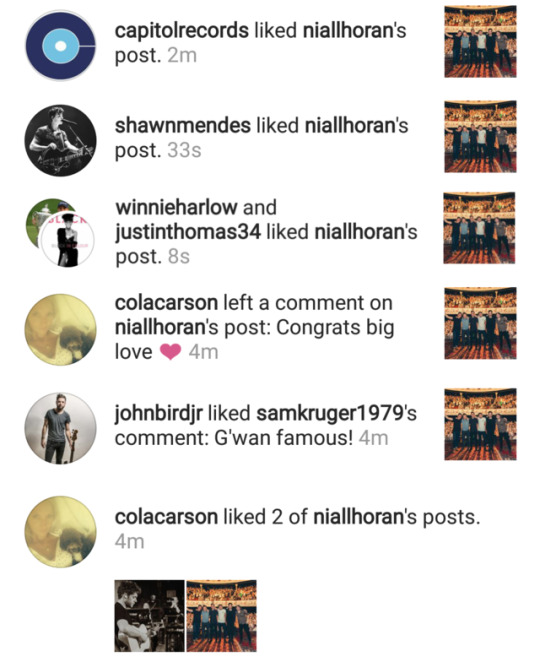
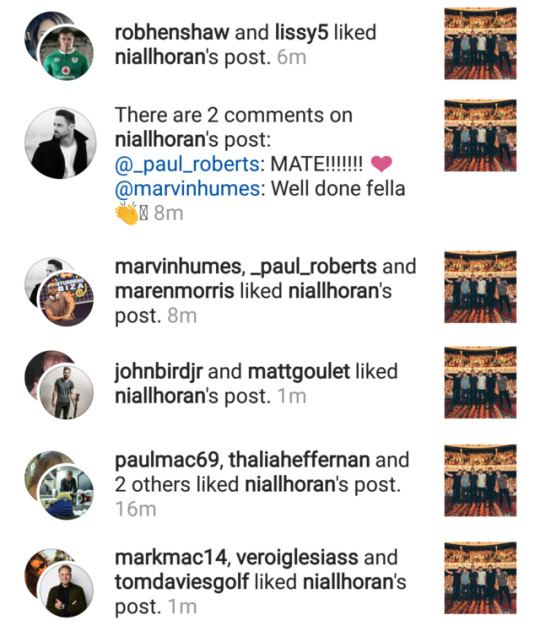

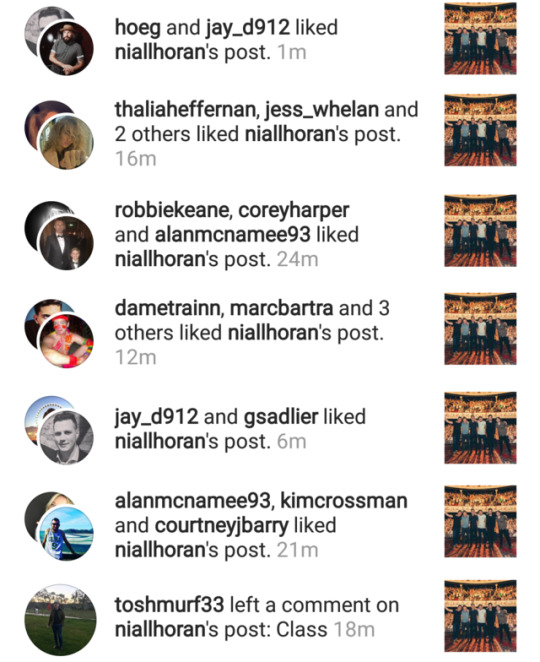
niall
#niall's friends on niall's ig#mark mcdonell#vero iglesias#tom davies#paul mcdonell#thalia heffernan#john bird#matt goulet#marvin humes#paul roberts#maren morris#robhen shaw#melissa rende#tosh murf#alan mcnamee#kim crossman#courtney barry#jay dilger#greg sadlier#damien moran#marc bartra#robbie keane#corey harper#jess whelan#jon hoeg#cola carson#sam kruger#winnie harlow#justin thomas#capitol records
20 notes
·
View notes